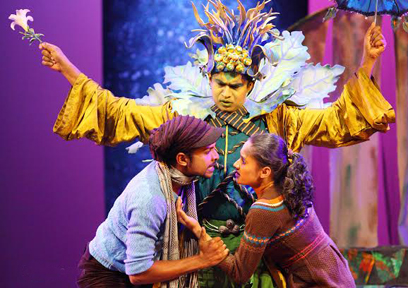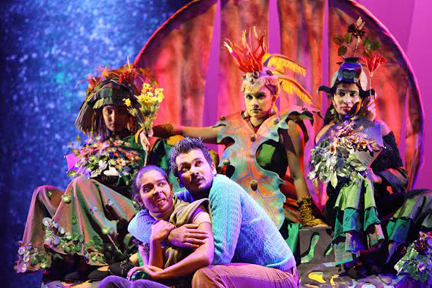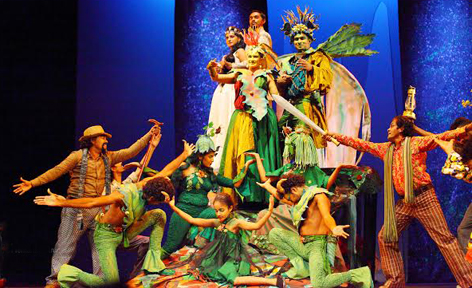|
DRAMA
REVIEW
Premawantha Kumarayo:
Shakespeare gets a creative Sinhala twist
by Dilshan Boange
 What place do shotguns, binoculars, corduroys, and long sleeved
sweaters have in depicting times of ancient Athenian society of
Shakespeare's A Midsummer Night's Dream? But then let's not forget Orson
Welles staged Shakespeare's Julius Caesar adopting black lounge suits
instead of togas, and Visakha Vidyalaya donned a traditional Sinhala
costume motif on Romeo and Juliet in full measure (for measure), at the
All Island Shakespeare Drama Competition finals, if memory serves me
right, in 2000. What place do shotguns, binoculars, corduroys, and long sleeved
sweaters have in depicting times of ancient Athenian society of
Shakespeare's A Midsummer Night's Dream? But then let's not forget Orson
Welles staged Shakespeare's Julius Caesar adopting black lounge suits
instead of togas, and Visakha Vidyalaya donned a traditional Sinhala
costume motif on Romeo and Juliet in full measure (for measure), at the
All Island Shakespeare Drama Competition finals, if memory serves me
right, in 2000.
Shakespeare today lends to creative ventures that offer multifarious
renditions of the timeless plays of the Bard of Avon. And on February
12, as 'Valentine's Weekend' commenced, I sat at the Wendt and watched
Premawantha Kumarayo came to life in a feast of colour and visual
delightfulness.
Presented as a Sinhala version of A Midsummer Night's Dream, this
entertaining work of Sri Lankan theatre was directed by seasoned actor
of the screen and stage, Priyankara Rathnayaka. The script is credited
as a translation by Jayawathi Jayasinghe and the play is produced by Lal
Handapangoda.
 The
costumes were creative, attractively executed and deserve special
applause. Stage and set design offered appreciable stagecraft and
achieved a good balance between devising for logistical needs of
switching between scenes and locales. A Midsummer Night's Dream after
all is a story that moves between the realms of humans and the surreal
forest dwelling fairy folk. The way the forest slowly grew and withdrew
with the use of umbrellas painted green and dressed up as shrubbery was
a factor that achieved subtleness of the surreal. The
costumes were creative, attractively executed and deserve special
applause. Stage and set design offered appreciable stagecraft and
achieved a good balance between devising for logistical needs of
switching between scenes and locales. A Midsummer Night's Dream after
all is a story that moves between the realms of humans and the surreal
forest dwelling fairy folk. The way the forest slowly grew and withdrew
with the use of umbrellas painted green and dressed up as shrubbery was
a factor that achieved subtleness of the surreal.
Present day vernacular
Putting together a translation of an English script of any vintage to
Sinhala is by no means a cakewalk. Sinhala is a rich language with
multilayered nuances of hierarchism and linked to the factors of class
between speakers and addressees. The use of language in this play
interestingly showed difference of tiers that ranged from the more
literary, antiquated Sinhala of yore to present day vernacular. That
factor showed the levels of class of the different characters.
The character of Peter Quince, who in this play was referred to as
'master', along with his crew of aspiring thespians, spoke a more
colloquial Sinhala, whereas the others spoke a more literary Sinhala.
The latter could have been intended to work as the dialogic element that
lends a 'Sinhala sense' of 'Shakespearean grandeur' to the play.
Comedy is not an easy genre to masterfully deliver. Shakespeare in
today's context may not sound the most likely generator of
side-splitting laughter. But riotous laughter was generated at a number
of instances, which speaks much of the directorial vision crafted and
actor skill harnessed to deliver what was achieved through Premawantha
Kumarayo as a comedy for contemporary Sri Lanka. Theatrical antics of
bodily agility offer vivacity and liveliness, and when directed
skilfully, show a motion of rhythm and interplay between characters
outside the verbal narrative. This notable element was commendably built
into the performance and well executed to achieve the larger goal of a
comedy for modern audiences. Song, dance and frolic were elements woven
to the 'fabric of performance' that defined the scheme of the narrative
as one geared to offer an experience of entertainment.
 On
the aspects of this play's base as a 'translation', it must be noted
that the names of all the major characters and most minor ones were as
per Shakespeare's script. Although Quince was called 'master' his troupe
remained faithful to Shakespearean christening. Bottom, Snug, Flute were
names that were present although the play they staged was not named
Pyramus and Thisbe, the classic Greek story by Ovid, as per A Midsummer
Night's Dream. Instead of Pyramus and Thisbe Premawantha Kumarayo
presented two very contemporary Sinhala names, although the storyline
remained unchanged. On
the aspects of this play's base as a 'translation', it must be noted
that the names of all the major characters and most minor ones were as
per Shakespeare's script. Although Quince was called 'master' his troupe
remained faithful to Shakespearean christening. Bottom, Snug, Flute were
names that were present although the play they staged was not named
Pyramus and Thisbe, the classic Greek story by Ovid, as per A Midsummer
Night's Dream. Instead of Pyramus and Thisbe Premawantha Kumarayo
presented two very contemporary Sinhala names, although the storyline
remained unchanged.
Faithful fairies
In that respect, a notable 'adaptation' aspect as opposed to a
'translation' can be noted. I was also curious to see how the wild
flower 'Love in idleness' would be translated. It was not given any
specific term. Avoiding naming it, the juice of a particular flower was
sought by Oberon to have his faithful fairies utilise to cast in motion
the chain of comedic mischief that forms the central twists in the
story.
Among the actresses, the one playing Hermia proved to be the one with
the most projected performance as her voice was an asset to her,
although the actresses portraying Titania and Hippolyta needed better
voice projection. Those who performed as Lysander and Demetrius did a
commendable job. The little girl who played the fairy 'Cobweb' whose
name was crafted as a Sinhala translation -'Makuludeli', too, albeit
occupying a very minor space, did her part well. Priyankara Rathnayaka
as Bottom was a treat. The players performing the roles of 'Master's
theatre troupe' all performed very well and won the audience's cheer.
Is the play that doesn't have any strong negative points deserving of
censure? It would seem so.
Teen teledrama culture
 For
the life of me I couldn't understand what possessed the director to use
the signature James Bond theme music that is the trademark opening of
all 007 movies, to announce the entry of Oberon and Titania! The
spectacular visual entry of the King and Queen of fairies coupled with
that music element ruptured the fabric of the narrative and hit a low
point, instead of the climax it could have been with better music
direction. The 007 theme was a crass injustice to a production that was
in other respects quite well done. This particular juncture of the
performance must be seriously rethought for future performances. For
the life of me I couldn't understand what possessed the director to use
the signature James Bond theme music that is the trademark opening of
all 007 movies, to announce the entry of Oberon and Titania! The
spectacular visual entry of the King and Queen of fairies coupled with
that music element ruptured the fabric of the narrative and hit a low
point, instead of the climax it could have been with better music
direction. The 007 theme was a crass injustice to a production that was
in other respects quite well done. This particular juncture of the
performance must be seriously rethought for future performances.
Further, I can't help but wonder if the inclusion of a touch of Elvis
Presley through the song 'Can't Help Falling in Love' (from the film
'Blue Hawaii') was in keeping with the lingual scheme of the play. A
modern English love song being sung in a Sinhala version of a
Shakespearean play seemed as though catering to the demands of popular
teenage tastes, pandering to the 'teen teledrama culture'. However, I
wouldn't say it didn't lend a touch of romantic ballad to the
romantic-comedy theme of the play as a narrative, which adopted modern
elements, although whether it is fully congruous with the larger
framework of the play is strongly questionable. Also I wouldn't say it's
unquestionably dismissible as the 007 entry theme!
Can Premawantha Kumarayo qualify as a translation of A Midsummer
Night's Dream? The title itself translates to mean 'Romantic Princes' in
English. But considering what I have observed, I Premawantha Kumarayo is
more a creative rendition of A Midsummer Night's Dream in Sinhala,
incorporating aspects of adaptation rather than a faithful translation.
In overview, I would say Premawantha Kumarayo can be applauded as a
success, which offered its audience a worthwhile, entertaining theatre
experience. |

